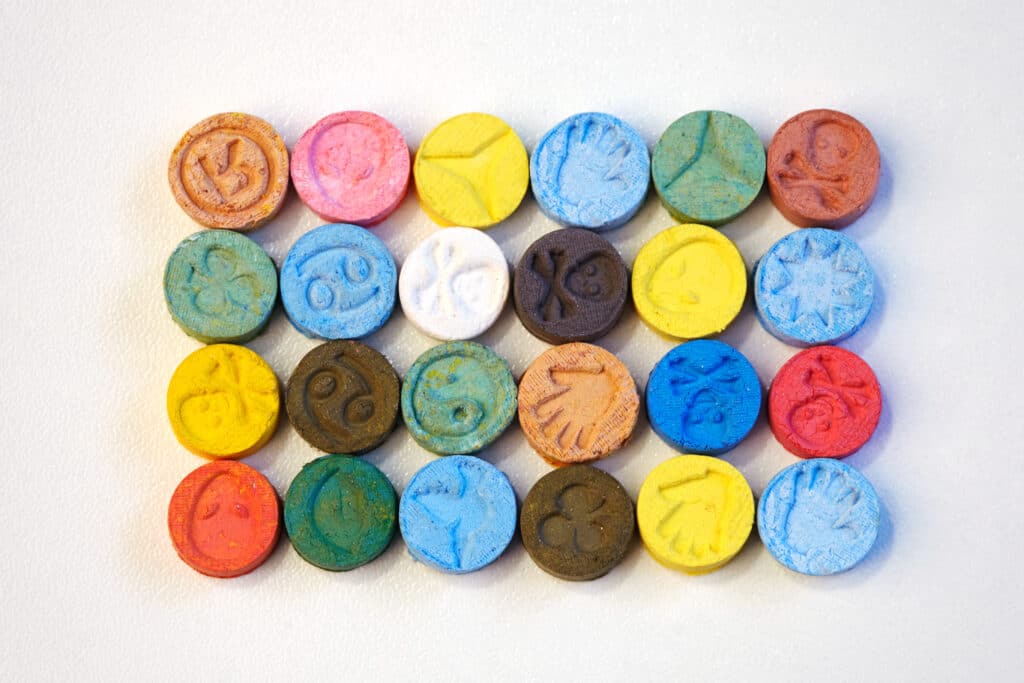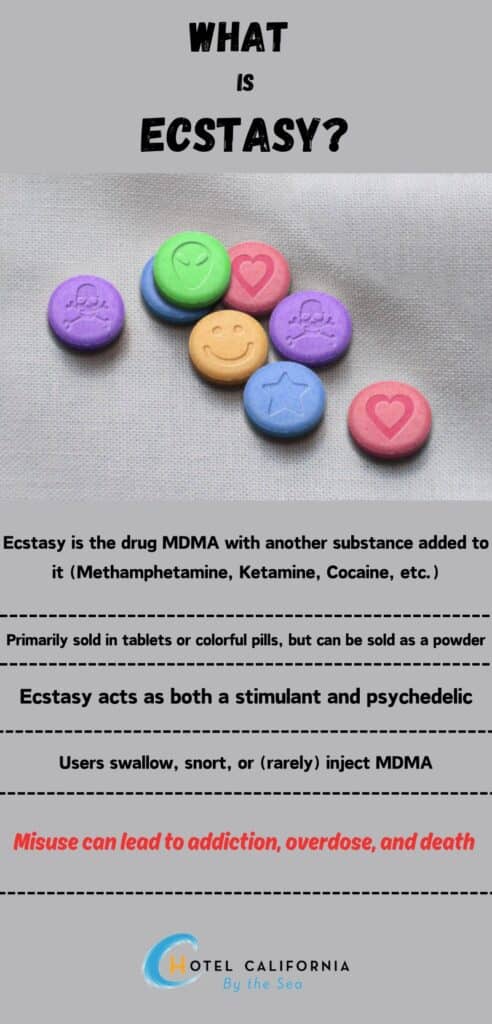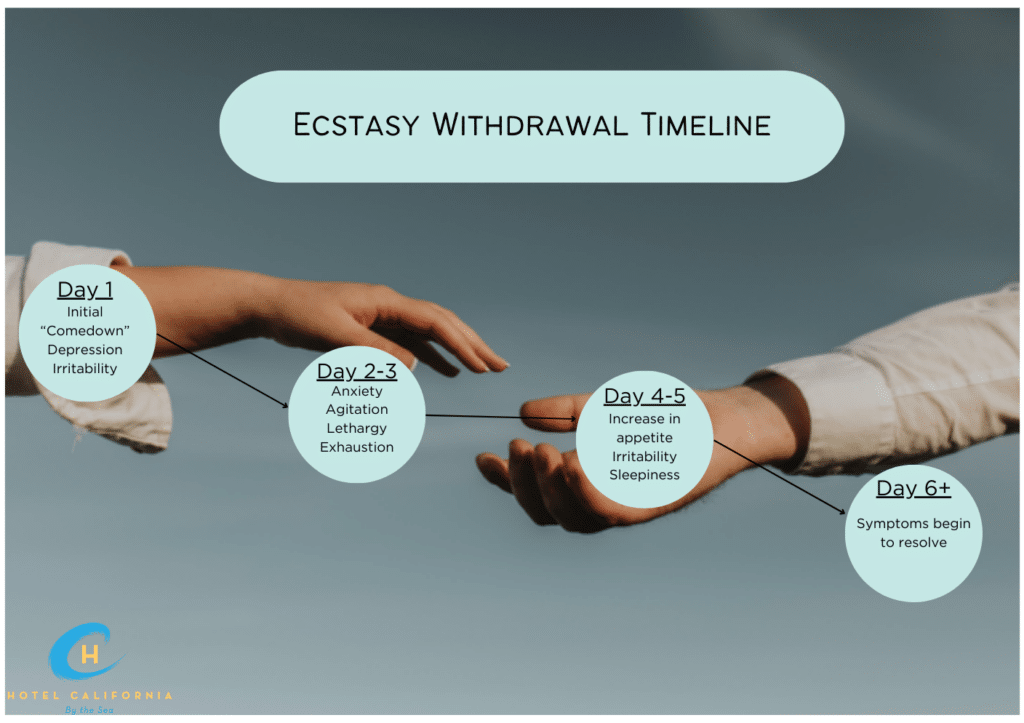How long does Ecstasy stay in your system? How long do the effects last?
Ecstasy, more commonly referred to as molly, is a popular party drug. The club drug is wildly popular among young people and young adults. According to the National Institute on Drug Abuse, in 2021, an estimated 2.2 million people reported using ecstasy. Ecstasy or 3,4-Methylenedioxymethamphetamine (MDMA), is an illicit stimulant, psychedelic and synthetically produced drug.

Ecstasy is a controlled substance that when abused, produces feelings of euphoria, energy, and a sense of emotional closeness with others. The drug can also produce slight hallucinogenic feelings which distort the user’s sense of awareness, apprehension of time and observations of color and texture. The combination of effects produced by ecstasy often leads to higher chances of tolerance, abuse and addiction to the substance.
How is ecstasy abused? Stacking. Stacking is taking three or more tablets of ecstasy at once in an attempt to induce euphoric feelings. Piggy backing. Piggy backing consists of taking a series of tablets/pills over a short period of time. Candy flipping. Candy flipping is the co-use of both ecstasy and LSD. Molly is most often used in conjunction with other mind-altering substances such as alcohol and marijuana. Because the drug is illegal and unregulated, molly is often laced or cut with other substances such as ketamine, cocaine, bath salts, amphetamines and even over-the-counter cough medications. This can lead to dangerous and unknown side effects.
What is Ecstasy?
The stimulant increases activity in the central nervous system and works to flood the brain and body of mood-enhancing chemicals such as serotonin, dopamine and norepinephrine. Molly works by increasing the levels of these three brain chemicals to higher amounts than normal.
These chemicals are also in charge of regulating and balancing energy levels, the brain’s reward system, appetite, changes in mood, sleep cycles, pain reception and blood pressure. It enhances the release of the three neurotransmitters and blocks their reuptake, creating more of the chemicals available for the body to use. However, releasing large amounts of these chemicals can cause significant depletion of the neurotransmitter chemicals and contribute to developing negative psychological side effects that users often experience when abusing the drug.

Serotonin – Affects mood, sleep, appetite and releases hormones that increase feelings of trust and empathy.
Dopamine – Works to raise energy levels and activity levels within the brain.
Norepinephrine – Affects the cardiovascular system by raising blood pressure and heart
Ecstasy or molly often comes in powdered or pill form which users ingest orally or snort intranasally. When ingested orally, the drug must go through the stomach before making its way into the intestine. When it is absorbed into the bloodstream, that is when users begin to feel the effects of the drug. Snorting the drug takes it directly into the bloodstream resulting in a much quicker onset of effects.
When molly enters the bloodstream, it is carried out into the liver where the substance is broken down and processed. The liver breaks down the drug into a chemical compound called metabolites. These metabolites are then moved to the kidney, where it is filtered out of the bloodstream and then moved to the bladder for excretion.
This makes liver health important. If the liver is not functioning properly, it could make it more difficult for the body to break down the chemicals. In addition, if the liver is overwhelmed with large amounts of chemicals, it can also make it difficult to perform its function properly, leading to a toxic build-up of the drug. And ultimately leading to negative side effects such as overdose and death.

How long does Ecstasy stay in your system?
According to research and studies from 2011, ecstasy can generally be detectable between 24-72 hours after a person has taken the drug. It can remain in the body in small traces for up to 5 days or more. Molly’s half-life is about 8-9 hours. Compared to some other mind-altering substances, molly has a relatively short half-life and can leave the system more quickly than others. It takes an average of five half-lives for the body to eliminate the drug from the body.
Through a urine test, molly is still detectable between 1-3 days. In a saliva test, molly is still detectable for up to four days. And through a blood test, molly can be detectable between 1-2 days. If high doses of molly are ingested, molly can be detected in urine as soon as 30 minutes after the initial dose. In general, the stimulant substance can stay detectable in body fluids between 1-3 days after initial ingestion.
Is there a way to speed up or slow down the metabolism of the drug? No. There is nothing you can do to slow down or speed up the processing of the drug. Drinking too much water to try and “flush out” the drug can lead to water intoxication. This is because ecstasy increases the body’s water retention. Too much water is dangerous. Exercising and trying to “sweat off” the drug can cause the opposite effect and lead to dehydration. Both conditions lead to dangerous side effects while on ecstasy.
Factors that contribute to the metabolism of Molly in the body
- Age
- Body mass index – weight and height impact how fast metabolism works; a larger person can metabolize substances more quickly than a smaller person
- Individual metabolic weight
- Liver and kidney function – a damaged liver and kidney can make removal of the drug slower
- Genetics
- Drug dosage – larger or multiple doses stay in the system longer
- Purity of the drug – ecstasy is unregulated so the potency of the drug is generally unknown and can affect how pure or diluted the drug compound is
Check Your Insurance Coverage for FREE
Find out if your insurance covers addiction treatment in minutes. We accept most insurance!
How long do the side effects of Ecstasy last?
The effects of molly can begin about 20 minutes to an hour after the initial dose. The peak effects take place at the two-hour mark. Generally, it takes an average of 3-6 hours for the drug “high” to wear off with the initial rush of feelings lasting for about two hours. In some cases, mood disruption side effects such as irritability, aggression, anxiety and depression can last for up to a week after the initial drug dose.
General Side Effects of Ecstasy Abuse
- Paranoia
- Panic attacks
- High blood pressure
- Involuntary jaw clenching
- Fluctuation in body temperature
- Sweating, chills and nausea
- Agitation
- Blurred vision
- Loss of appetite
- Lack of focus
- Dehydration electrolyte imbalance
Addictive Side Effects
- Euphoria
- Openness and empathy towards others
- Extraversion
- Increased sensory perception
- Increased energy
Negative Side Effects
- Muscle cramps
- Increased heart rate
- Increased blood pressure
- Insomnia
Long-Term Side Effects
- Memory impairment
- Difficulty with decision-making
- Increased impulsivity and lack of self-control
- Difficulty sleeping
- High risk for heart disease
- Anxiety and depression
- Stroke and seizure
Reach out to Hotel California by the Sea
We specialize in treating addiction and other co-occurring disorders, such as PTSD. Our Admissions specialists are available to walk you through the best options for treating your addiction.
Treatment for Substance Use Disorder
Ecstasy is a popular social drug used by young people in the US and worldwide. The hallucinogenic stimulant can produce intense feelings of euphoria and can become habit-forming and addictive. Hotel California by the Sea specializes in treating substance use disorders in young people. Young people often have different challenges and obstacles they face in addiction treatment and recovery compared to other age groups.
We provide detox, residential, PHP and IOP treatment programs. Evidence-based therapies including CBT, DBT and group therapy provide intense and rigorous treatment. Oftentimes, substance use disorders are followed by or triggered by other mental health disorders. Hotel California by the Sea also treats clients with co-occurring mental health conditions. We believe in a well-rounded approach to treatment through physical, emotional and psychological aspects of recovery. Our unique program focuses on helping this highly affected age group by providing the necessary tools, resources and support they need to overcome their addiction.
References:
https://npaddictionclinic.com/blog/how-long-does-ecstasy-stay-in-your-system/
https://www.rehabcenter.net/mdma/detection-time/
https://www.healthline.com/health/how-long-does-molly-stay-in-your-system
https://recovered.org/stimulants/mdma-ecstasy-molly/ecstasy-mdma-molly-in-system
https://www.medicalnewstoday.com/articles/327526
https://www.dea.gov/sites/default/files/2020-06/Ecstasy-MDMA-2020_0.pdf
https://www.camh.ca/en/health-info/mental-illness-and-addiction-index/ecstasy
